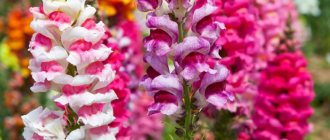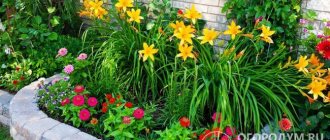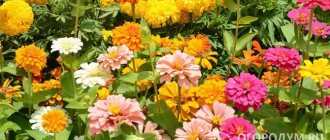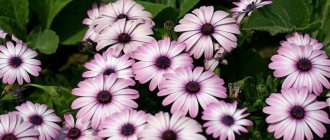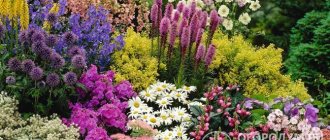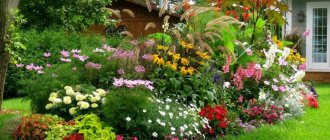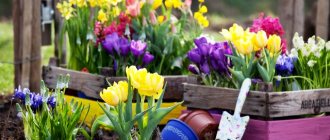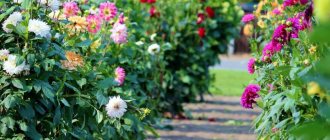Review author: Terrari School of Design
There's nothing better than a garden filled with gorgeous flowers. Their seductive scents and bold hues are the perfect way to highlight the beauty of the summer season.
But if the garden starts to look worse as temperatures get warmer or cooler, it's important to make a plan to keep the beds blooming from spring through fall.
This is a list of flowers that tolerate both heat and cold, shade and full sun. They can be planted and combined as desired, and these flowers are also well suited for use in landscape design.
With the help of a brief description of flowers, any gardener can easily collect the flowers they like for their country garden.
Sunflowers
- Annuals
- Colors: yellow, brown, yellow with red specks
- Height: 1.-3 meters
- Blooms in summer
- Most varieties are drought and heat resistant.
- Attracts bees, birds and butterflies
- Grows well in the sun
- Tolerates most soil types (except wetlands).
- May require support to prevent stems from breaking
Primrose
Early flowers for the garden are, of course, primroses. They often lead the May flower beds. The variety of primrose species allows you to choose varieties to suit every taste and extend flowering over several weeks. Despite their decorative value, these flowers are unpretentious and do not require special care. To avoid self-seeding, remove faded inflorescences in a timely manner. It is recommended to divide primrose rosettes every 3-4 years.
Echinacea
- Perennials
- Colors: yellow, orange, white, purple, pink, two-tone and others.
- Height: up to 1.5 meters in height
- Blooms from summer to late autumn
- You can make beautiful bouquets from them
- Attracts pollinators and birds
- It is worth sowing seeds in spring or autumn.
- Loves rich, well-drained soil.
- Tolerates drought
It is best to plant in full sun. To experiment, try Lakota and Fire Coneflower to get a colorful combination of reds and purples in one plant.
Rating of ground cover perennials for the Moscow region
Not only tall, but also low flowering perennials are decorative. They help fill the space and thus give the composition a finished look.
Periwinkle
Creeping subshrub with blue or pink flowers. This perennial is able to survive even in the harshest conditions, so it will grow in the Moscow region without any problems.
There are 12 types of periwinkle
Duchesnea or Indian Cinquefoil
Ground cover with yellow flowers and red fruits. The height of the plant is no more than 5 cm, but it grows up to 1 m. Indian cinquefoil (Potentilla indica) easily withstands drought. Prefers to grow in shaded places.
It is recommended to plant Duchenea at the base of trees and shrubs
Arabis or Rezuha
A perennial flower no more than 30 cm high. There are about 12 types of culture. It takes root well in the conditions of the Moscow region. Forms cushion-shaped clumps that do not die off in the winter. Arabis flowers are five-petaled, white, pink or yellow.
Arabis prefers sandy, loose soil
Aubrietta
Perennial flower of the Brassica family. The plant easily tolerates the climate of the Moscow region and does not freeze in winter. Forms a living “carpet” that completely fills the free space. During flowering, it is covered with cherry-red or lilac flowers, which completely hide the foliage. The height of the perennial is 20-30 cm, and the diameter of 1 bush is 20-30 cm.
Aubrietta fully blooms 2 years after planting
Daylilies
A perennial herbaceous shrub that can bloom for a long time. Daylilies must be planted in groups, combining several species at the same time. The perennial forms tall peduncles, each of which contains up to 50 buds.
Repeated flowering varieties of daylilies have already been bred
Zinnias
- Annuals
- Colors: shades of red, orange, yellow, pink and white.
- Height: up to 50 cm in height
- Blooms in summer
- Varies in flower shape depending on the variety
- Attracts butterflies
- Loves rich, well-drained soil.
- Has moderate water needs
- Grows best in full sun
Rezuha
Rezuha (arabis) is a must-have plant for the “lazy” gardener - very unpretentious, winter-hardy, early and abundantly flowering. In gardens, Arabis is used mainly in alpine slides or planted in the foreground of flower beds. Most often, rezuha is found with small white flowers that have a honey aroma. But sometimes you can find bright pink and crimson colors.
At first glance, the rezuha may seem like an unremarkable plant, reminiscent of wildflowers. But Arabis also has more interesting forms, for example, the “Plena” unusual double flowers. And Arabis "Variegata" will decorate the flower garden all season long, thanks to the presence of a bright light border along the edge of the leaf.
Dianthus (clove)
- There are options for annuals and perennials
- Colors: shades of red, purple, pink and white.
- Height: most plants are from 20 to 50 cm, varieties up to a meter tall.
- Bright, fragrant flowers (with the scent of cloves)
- Blooms from May to August.
- Attractive evergreen green foliage
- Plant in well-drained soil
- Grow in full sun or light shade with more sun during the day
Grouse
In total, this genus of bulbous plants has about 180 species. In culture, only a few varieties of hazel grouse are most widespread, among which the most popular is the imperial hazel grouse . This spectacular primrose blooms in early to mid-May.
At this time, large drooping flowers appear on a long stem, densely covered with linear leaves arranged like the foliage of lilies. They are similar in shape to tulips or bells. And their color is most often orange and yellow.
The most notable feature of this species is the tuft of linear leaves located above the inflorescence. In combination with bright flowers, this “tuft” resembles an imperial crown, decorated with precious stones, which is where the name of the flower comes from.
To ensure that the bulb does not become smaller and the plant enjoys flowering every year, it is recommended to dig up the hazel grouse every year or once every two years. In summer, the bulbs are stored in a shaded place at a temperature of 20 degrees. Planted in the flower garden from August to October. When choosing a place for hazel grouse, it is important to consider that when you touch the plant, its foliage begins to emit an unpleasant odor.
Marigold
- Annuals
- A classic country flower that creates bright, beautiful spots in flower beds
- Colors: shades of yellow, red, gold, variegated - red with orange highlights.
- Height: from 15 cm to a meter in rare cases
- Blooms in spring, summer and autumn
- Grows quickly from seeds
- Repels mosquitoes
- Prefers well-drained soils and grows well in dry or sandy gardens.
- Requires good watering, but you need to let the soil dry out between waterings
- Should be grown in full sun
Rose
The “queen” of any garden is the rose. There are many varieties, shapes and colors. If you place a flowering bush in a flowerbed, you can always place low-growing plants around it, which will serve as an excellent complement to the chosen composition.
A climbing rose is a great option to show your creative imagination. Its branches can be attached to a wall, wrapped around a gazebo or to disguise an unsightly fence from neighbors.
Cosmea
- Annuals and perennials
- Colors: orange, pink, white
- Height: varieties 40 – 80 cm tall
- Blooms in spring, summer and autumn
- Grows quickly from seeds
- Repels mosquitoes
- Prefers well-drained soils and grows well in dry or sandy gardens.
- Requires good watering
- Should be grown in full sun with partial shade
Top 5 unpretentious and frost-resistant perennials for a summer residence in the Moscow region
Among all perennials, plants that are able to bloom profusely without requiring any care are especially popular. These crops are especially relevant for gardeners who do not have the opportunity to visit their dacha often.
Badan
An evergreen perennial flower of the Saxifraga family. The height of the plant reaches 35 cm. It forms paniculate inflorescences from goblet-shaped flowers in pink, white and red shades.
Read more Blue and blue perennials: photos and names, top blooming all summer
Bergenia prefers slightly moist soil
Lilies
This perennial flower is especially popular because it is highly frost-resistant and is distinguished by the beauty of its gramophone flowers. The variety of types allows you to choose different options for decorating your dacha. The plant blooms in the first year, if the diameter of the bulb allows.
Lilies need to be replanted every 3 years.
Garden chamomile
This flowering perennial is ideal for a summer cottage in the Moscow region. The plant is undemanding to care and soil composition, and at the same time it fully develops and blooms profusely every year. The classic type of perennial with white petals in several rows and a bright yellow center is very popular. But there is also lilac chamomile.
The diameter of chamomile flowers reaches 7-10 cm
Platycodon
Herbaceous perennial with bell-shaped flowers. Flowering lasts 8-10 weeks. The color of the petals can be purple, blue or white. The height of the plant reaches 0.8-1.2 m.
Platycodon goes perfectly with low-growing phloxes
Loosestrife point
It is a low-branched plant with erect shoots. Forms spike-shaped inflorescences of a bright yellow hue. Loosestrife (Lysimachia punctata) tolerates the climate of the Moscow region well. The height of the bushes reaches 70-80 cm. It can grow in one place for 10 years.
Loosestrife blooms for 2 months
Convolvulus
- perennial
- Colors: white, purple, pink, red, blue, there are varieties of variegated colors
- Height: spreads from one meter to 2 meters
- Blooms in late summer or early autumn
- Bindweed is a flower that sows itself; you need to be careful not to fill the entire summer cottage with it
- Attracts birds and butterflies
- The seeds are very toxic if ingested
- Prefers moderately fertile, well-drained soils. The plant needs to be watered weekly during dry periods.
- Plant in full sun
Basic rules for creating flower beds
Flower beds from perennial plants are created for more than one year, so you need to be very careful about the layout and selection of components. Before starting all the work, let us recall the simple rules for arranging flower beds that landscape design requires of us.
— The flower garden should be harmoniously combined with the overall design of the estate.
— Have convenient access for further care.
— The spacing between plants when planting should include room for growth.
— Plants should not cover each other.
— It is better to plant low-growing plants in groups; the larger the specimen, the smaller the group should be.
— All plants in the flower garden should have similar requirements for conditions and not oppress each other.
— When choosing a color scheme for a flower bed, use a color wheel; all shades should be in harmony with each other.
Nasturtium
- annual
- Colors: shades of orange, red, yellow, cream
- Height: 1-1.5 meters
- Fast growing and colorful
- Blooms from May to September.
- Edible leaves and flowers (recipe: Sautéed Halibut with Nasturtium Butter)
- Needs well-drained soil
- It is worth watering regularly, but without overflowing
- Plant in full sun
Lilies of the valley
The next flowers that have a beautiful appearance, a delicate aroma and perfectly complement the garden are lilies of the valley. They replace the first spring flowers and bloom in May. They can be planted with seeds, but it is better through seedlings.
The main thing that a gardener needs to know is that lily of the valley has a good root system, and when planting, you need to limit the place where it spreads. In the area where the flower will be planted, you need to make a flower bed for it in advance: dig a barrier (pieces of slate, special garden shields) into the ground to a depth of 0.5 meters. This will create a barrier for lily of the valley seedlings throughout the garden.
Lilies of the valley are very easy to care for. They are representatives of “wild” nature, so they do not require careful care. After the flower has faded, berries appear on the stem - another decoration for the garden.
Pansies
- Grown as annuals (can be perennial/biennial in zones 6-10).
- Colors: a variety of colors from white to dark purple
- Height: about 20cm high
- In warmer climates, pansies will bloom throughout the winter and early spring.
- Attracts butterflies
- Loves rich, well-drained soil.
- Needs regular watering
- Blooms in sun or partial shade
- Grows best at a temperature of 15-24 degrees
Mountain cornflower and one-flowered
This perennial plant, familiar to many, is distinguished by its ease of care, undemandingness to soil composition, and resistance to drought and disease. All this, combined with very beautiful and fairly early flowering, makes cornflower a popular crop among beginning gardeners.
Most often they are used in naturgardens, in meadow-style plantings and on Moorish lawns. Plus, today many varieties of cornflower have been bred not only in the usual blue color, but also in pink, white, and soft lilac shades.
- Growing cornflowers in the garden
Cornflower is considered a wildflower, but this does not mean that it cannot be planted in a flower garden.
Snapdragon
- Grown as annuals (can be perennial in zones 5-10)
- Colors: white, yellow, pink, red, orange, peach, purple and dark purple.
- Height: 20-25 cm in height
- Blooms from spring to fall in cool summer growing conditions.
- Attracts butterflies
- Prefers well-drained soil
- The base of the plant needs to be watered regularly
- Blooms best in full sun
Forget-me-not, or gourd
Small, numerous flowers of white, blue, lilac, violet colors attract the attention of all people passing by. Forget-me-not feels great in the shade, and here the color of the flowers is usually brighter. Therefore, this compact plant (10-30 cm high) can perfectly decorate the tree trunks.
Geranium (Pelargonium)
- Grown as annuals
- Colors: white, pink, red, lavender, violet, purple and crimson
- Height:7-50cm in height
- A flower that does not require care from spring to frost
- Suitable for growing in window pots, hanging baskets, containers or just in the garden bed.
- Attracts birds and butterflies
- Grows in rich, well-drained soil.
- You need to water regularly, but do not overwater.
- Prefers full sun/midday shade in hot climates
For a beautiful and well-kept flower garden and longer stems and lush flowers:
- Plant flowers close to each other in your summer cottage. This will reduce the number of weeds and increase the number of flowers in the garden.
- If flowers are grown for cutting, do not forget to grow foliage and “filler” plants for compositions
- To allow flowers to grow and reproduce naturally, but within reach of the lawnmower blades, it is worth installing rectangular slabs around the beds.
- Make the paths between the flower beds wide so that the flowers do not get under your feet when walking through the garden.
- choose smaller varieties to reduce pruning time, and plant shrubs in the center of the flower bed to provide year-round structure and height.
- Water your flowers regularly
- Collect seeds from annuals and perennials for next year
Tulips
The parade of primroses continues in May. All that was left of the crocuses that had raged just recently were clearings of modest thin leaves. But tulips are beginning to gain more and more momentum, botanical species are being replaced by hybrid varieties.
Among the first to bloom are such groups of tulips as “simple early” and “double early” . Towards the middle of May, tulips of the "Triumph" and "Darwin hybrids" . At the end of May-beginning of June they are replaced by the latest ones: “lily-flowered” , “parrot-flowered” , “late double” , “simple late” , “green-flowered” and others.
Don't forget that tulip leaves should not be cut before they are completely dry. Also, most varieties require digging in the summer.
